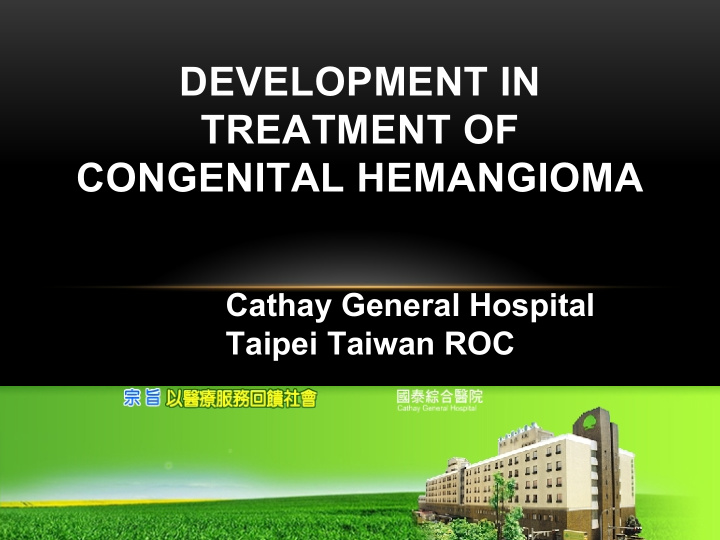



DEVELOPMENT IN TREATMENT OF CONGENITAL HEMANGIOMA Cathay General Hospital Taipei Taiwan ROC 1
• AUTHORS: • Chun-yu Wang, Jian-Jr Lee, Carlos Chi-Ho Liu, Ming-Ting Chen • The Plasitc Surgery Department of Taipei Cathay General Hospital • Nothing to disclose. 2
BACKGROUND • Congenital hemangiomas are rare, benign vascular tumors that, unlike infantile hemangiomas, are present and fully grown at birth. They present as bossed plaques or exophytic masses located on the head, neck or limbs. 3
MATERIAL AND METHODS • we presented our three cases of congential hemangioma, including pre- operative image study, surgical technique and post-operative follow-up. • Pre-operative MRI, 3D-CTA revealed the existence of feeding vessels. Thus we ligated the feeding vessels before excision of the vascular tumors. 4
MATERIAL AND METHODS • Excisions with STSG coverage were performed in the first two cases over forearm and leg. • We used tissue expander to reconstruct the defect of the third case over posterior shoulder to prevent scar contracture. Pathological report proved the lesions as congenital hemangiomas . 5
RESULTS • In one year follow-up, patients were all satisfied with both the functional and aesthetic results. • 6
CASE 1 • A 15 female suffered a reddish mass over left forearm since birth.Thermogram showed hot spot of the lesion. Pre-OP CTA and MRI all revealed feeding vessels to the tumor. We identified the feeding arteries and ligated before excision. STSG coverage was performed. 7
Upper left: A 4*4 cm reddish lesion over the patient’s left medial forearm. Upper right: CTA revealed a feeding vessel branched from ulnar artery. Lower left: MRI in T2 weighted showed a prominent vessel acrossing the FCU to supply the vascular tumor. Lower right: Thermogram showed hot spot of the lesion. 8
Tumor excision after feeding vessels ligation. STSG was used to cover the defect. 9
CASE 2 • A 2-year-old female with a large (5*6cm) bluish tumor over left medial leg since birth. Mapping the feeding vessels via audible Doppler was performed preoperatively. Then ligation of feeding vessels proceeded before tumor excision. STSG coverage was performed in this case . 10
Upper left: A 5*4 cm reddish lesion over the patient’s left medial leg. Upper middle and right: CTA revealed a feeding vessel branched from popliteal artery. 11 Lower left: MRI in T2 weighted showed a prominent vessel supply the vascular tumor.
Tumor excision after feeding vessels ligation. STSG was used to cover the 12 defect.
CASE 3 • A 5-year-old male suffered a reddish vascular tumor ( 7cm*7cm) over right posterior shoulder with central necrosis. 3D-CTA and MRI all revealed feeding vessels. In this case, we used tissue expander to reconstruct the defect successfully. Pathological report revealed congential hemangioma. 13
This patient suffered a painful vascular tumor with ulceration since birth. 14
Right: CTA revealed a feeding vessel branched from circumfex of subscapular artery. 15
2012.08.01 A 250 cc round shape tissue expander implanted in the scapular region with port over right apex of shoulder 16 2012.01.02 2012.08.13
2013.01.02 Tumor excision after ligation of feeding Vessel. Lower right: F/U for 1 year. \ 17 2013.01.02 2013.02.18
Pathological report showed endothelial cell hyperplasia with negative immunohistological stain of GLUT-1 18 but positive of CD 31.
CONCLUSION • Ligation the feeding artery of congenital hemangioma provided a safe and efficent way to treat this tremendous congenital anomaly and bring satisfying results. 19
THANK YOU FOR YOUR ATTENTION 20
Recommend
More recommend